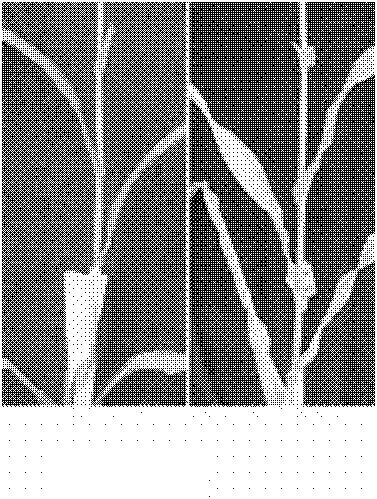Method for preparing corn type II embryogenic calli
A technology of embryogenic callus and corn, applied in the field of preparation of type II corn embryogenic callus, to achieve the effects of excellent agronomic properties, shortened cultivation, and easy regeneration
- Summary
- Abstract
- Description
- Claims
- Application Information
AI Technical Summary
Problems solved by technology
Method used
Image
Examples
Embodiment 1
[0039] Example 1. Preparation and verification of a maize inbred line-NGY302 capable of producing type II embryogenic callus
[0040] 1. Preparation and verification
[0041] (1) Preparation
[0042] 1. Selfing the high-oil inbred line GY302 to obtain F1 generation seeds;
[0043] In mid-August 2009, the high-oil inbred line GY302 was self-crossed at the experimental station of China Agricultural University in Changping, Beijing, and the self-bred F1 generation seeds were obtained.
[0044] 2. Type II embryogenic callus induction:
[0045] 100 immature embryos of F1 seeds were taken for embryogenic callus induction, and 100 embryogenic callus were obtained, from which type II embryogenic callus was selected, and the induction rate of type II embryogenic callus was counted.
[0046] Embryogenic callus induction method: 10 days after field self-pollination of the high-oil material GY302, corn ears were sterilized with 10% sodium hypochlorite aqueous solution for 10 minutes, t...
Embodiment 2
[0106] Example 2, Preparation of type II embryogenic callus with NGY302
[0107] 1. Method I
[0108] The immature embryos of NGY302 were inoculated on the embryogenic callus medium, and cultured in a dark environment at 28°C for 2 weeks to obtain type II embryogenic callus;
[0109] The embryogenic callus culture medium is composed of N6 medium, 2,4-D, inositol, proline, sucrose, hydrolyzed casein and phytogel;
[0110] 2, the concentration of 4-D in the described induction medium is 2.2mg / l, the concentration of inositol in the described induction medium is 0.15g / l, the concentration of proline in the described induction medium is 2.8g / l, the concentration of sucrose in the induction medium is 30g / l, the concentration of hydrolyzed casein in the induction medium is 0.15g / l, the concentration of phytogel in the induction medium 8g / l.
[0111] N6 medium was purchased from Sigma, the product catalog number is C1416.
[0112] Results All the immature embryos used for culture...
Embodiment 3
[0125] Embodiment 3, contrast
[0126] A188 was disclosed in the document "Maize Somatic Cell Culture and Screening of Disease-Resistant Variants, 1993", and the public can obtain it from China Agricultural University.
[0127] In the summer of 2010, the seeds of A188 and NGY302 were planted in Beijing Shangzhuang Experimental Station respectively, and their agronomic traits were observed. Results The plants of A188 were short, the pollination and seed setting rate was about 80%, and the male and female flowering stages were uncoordinated, separated by 2 days; while the plants of NGY302 were strong, medium in height, and the pollination and seed setting rate was high, about 100%.
[0128] The immature grain embryos of A188 and NGY302 were planted on N6 medium respectively, placed in a dark environment at 28°C for 2 weeks, and observed whether the obtained callus was type I or type II.
[0129] In the same N6 culture, A188 induced 95% callus between type I and type II; NGY302 ...
PUM
 Login to View More
Login to View More Abstract
Description
Claims
Application Information
 Login to View More
Login to View More - R&D
- Intellectual Property
- Life Sciences
- Materials
- Tech Scout
- Unparalleled Data Quality
- Higher Quality Content
- 60% Fewer Hallucinations
Browse by: Latest US Patents, China's latest patents, Technical Efficacy Thesaurus, Application Domain, Technology Topic, Popular Technical Reports.
© 2025 PatSnap. All rights reserved.Legal|Privacy policy|Modern Slavery Act Transparency Statement|Sitemap|About US| Contact US: help@patsnap.com



